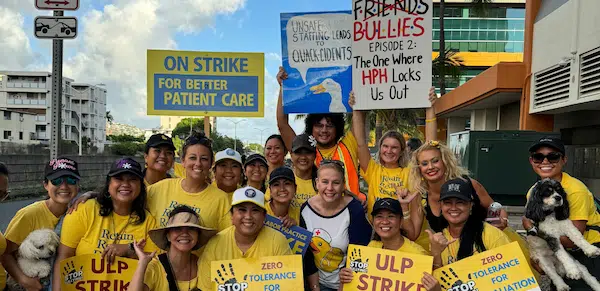In a malicious ploy, a hospital in Honolulu locked out its nurses after a one-day strike—and not just for a couple days, as hospitals often do, but indefinitely. The message was, you can come back only when you accept our demands.
But the nurses stuck it out. They kept building their support with daily demonstrations. And in the end, amid public outrage after elders got arrested in a solidarity protest, management agreed to nurse-to-patient ratio language, a first for the state.
The 630 nurses at Kapi’olani Medical Center for Women and Children struck on September 13 over unfair labor practices—specifically, ongoing retaliation against nurses who report unsafe staffing conditions, as documented by their union, the Hawaii Nurses Association.
I had traveled to Hawaii to support the strike, and I witnessed the subsequent lockout. When nurses attempted to return to work on September 14 for their scheduled shifts, they were stopped outside by unknown hospital personnel who read a prepared statement:
Kapi’olani notified HNA nurses that the lockout would occur at 0700 today and that the nurses would not be allowed to work until further notice. I’m asking you respectfully to leave the property.
The hospital administration was contending, without evidence, that this was an economic strike, rather than an unfair labor practice strike, paving the way for a legal lockout. This was the first lockout in Hawaii in 22 years.
ALOHA SOLIDARITY
Kapi’olani Medical Center is the only specialty women’s and children’s hospital for the state. It plays a crucial role in the health care of Hawaii’s children and families.
Management’s actions shocked me, because they ultimately affected sick children, and because we are in the midst of a national nurse staffing crisis. Unsafe nurse-to-patient ratios lead to more and more nurses leaving bedside positions.
As a nurse advocate, I’ve attended countless nursing strikes around the country, often centered on staffing demands, but this one stands out—not only for the retaliation the nurses endured, but also for the solidarity among them.
The meaning of Aloha is deeper than a greeting. To Hawaiians, it is a spirit of mutual compassion, respect, and caring for one another. I felt that spirit each time a nurse hugged me and thanked me for coming.
Their energy and gratitude on the strike line was palpable. And as I listened to their stories, it was clear how deeply they cared about their patients and community.
I believe it’s because of this spirit that the nurses felt betrayed when the hospital announced the indefinite lockout. That morning, union President Rosalie Agas-Yuu spoke for the nurses:
We are ready to work. We want to go up there to our patients, but if Kapi’olani does not want us in there, we want to hear it from your mouth personally.
Afterwards the nurses peacefully exited hospital property and gathered on the sidewalk. Many were in tears, as the reality of being without a paycheck began to sink in. And the bitter irony of a retaliatory lockout in response to a strike about retaliation was not lost on them.
TRAGIC RESULTS OF SCAB NURSING
In the days that followed, union members held powerful daily actions, including demonstrations, vigils, and a march from the state capitol to Hawaii Pacific Health headquarters. They were often joined by other nurses, members of other unions, and community leaders.
It took six days before management met to negotiate with the union. Members stood united even when the hospital threatened to cancel their health insurance at the end of the month. Eventually federal mediators were brought in.
At the same time, the Department of Health conducted an investigation inside the hospital, and stories of alleged patient neglect under the care of scab nurses began to come out.
Parents of a four-year-old patient who tragically passed away during the lockout told local news they believed “it wasn’t her time to go,” and described the poor care their daughter allegedly received. Parents of an 11-week-old infant reportedly opted to have their child transferred out of state for care.
HNA also appealed to the National Labor Relations Board for an injunction when the union first learned of the indefinite lockout; it is still awaiting a decision.
TIPPING POINT: GRANDPARENTS HANDCUFFED
But a turning point came on September 23, when 10 community members, dubbed “the Kapi’olani Ten,” were arrested during a peaceful civil protest in front of the hospital. Among those arrested were senior citizens, as well as State Representative-Elect Kim Coco Iwamoto and State House Candidate Ikaika Hussey.
The images of grandparents and community leaders being handcuffed and taken to jail sparked public outrage, and became a tipping point in negative publicity.
The lockout lasted 22 days. On October 1, the union and the hospital reached a tentative agreement that reportedly includes language addressing nurse-to-patient staffing ratios, making Kapi’olani the first hospital in Hawaii with ratio language.
I’m grateful to have witnessed this struggle—a lesson in the strength of solidarity.
Nurse Erica, as she is known on social media, is a nurse advocate, keynote speaker, and co-host of the Nurses Uncorked podcast.

